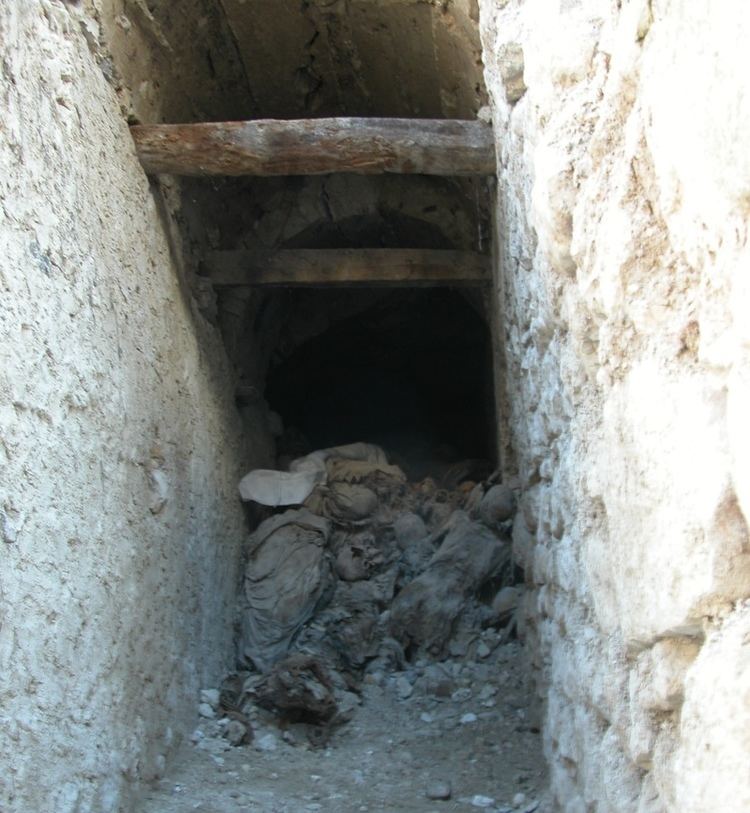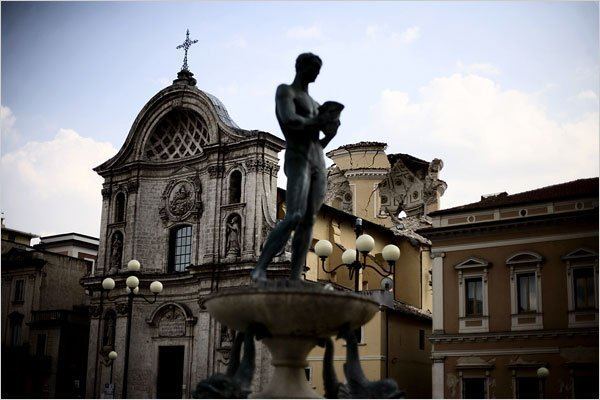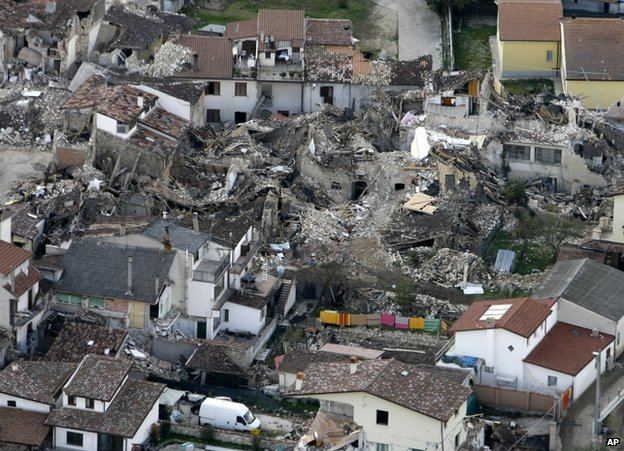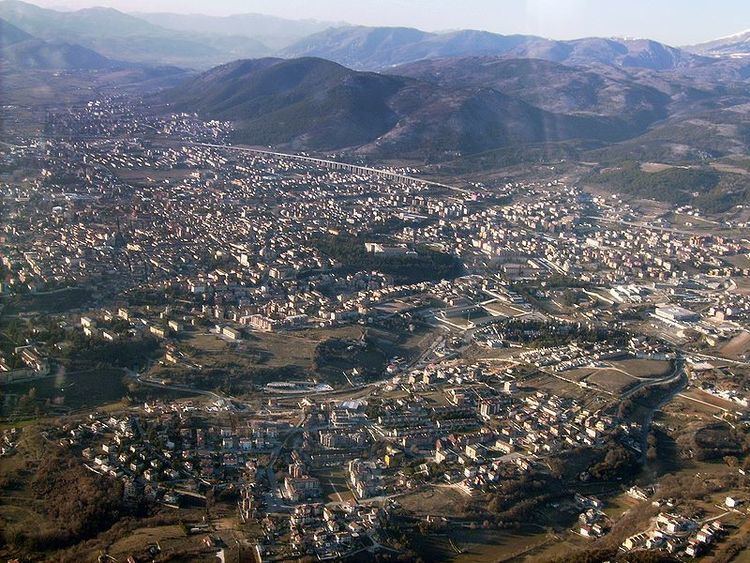Country Italy Elevation 714 m Province Province of LAquila University University of LAquila Area 466.9 km2 | Region Abruzzo Mayor Massimo Cialente (Democratic) | |
LAquila ( meaning "The Eagle") is a city and comune in Southern Italy, both the capital city of the Abruzzo region and of the Province of LAquila. As of 2012, it has a population of 68,304 inhabitants. Laid out within medieval walls on a hill in the wide valley of the Aterno river, it is surrounded by the Apennine Mountains, with the Gran Sasso dItalia to the north-east.
Contents
- Map of LAquila
- G8 laquila eu commission president arrives raw video
- Save laquila exhibit gala part one
- Geography
- History
- Main sights
- Culture
- LAquila cuisine
- References
Map of LAquila
LAquila sits upon a hillside in the middle of a narrow valley; tall snow-capped mountains of the Gran Sasso massif flank the town. A maze of narrow streets, lined with Baroque and Renaissance buildings and churches, open onto elegant piazzas. Home to the University of LAquila, it is a lively college town and, as such, has many cultural institutions: a repertory theater, a symphony orchestra, a fine-arts academy, a state conservatory, a film institute. There are several ski resorts in the surrounding province: (Campo Imperatore, Ovindoli, Pescasseroli, Roccaraso, Scanno).
G8 laquila eu commission president arrives raw video
Save laquila exhibit gala part one
Geography
Close to the highest of the Apennine summits, LAquila is positioned at an elevation of 721 metres (2,365 ft) in the Valley of the Aterno-Pescara, situated between four mountain peaks above 2,000 metres (6,600 ft).
The mountains block the city off from warm humid air currents from the Mediterranean, and give rise to a climate that is cool in comparison to most of central Italy, and dry. It has been said that the city enjoys each year 11 cold months and one cool one.
LAquila is approximately 100 kilometres (62 mi) east-northeast of Rome, with which it is connected by an autostrada through the mountains.
History
The citys construction was begun by Frederick II, Holy Roman Emperor and King of Sicily, out of several already existing villages (ninety-nine, according to local tradition; see Amiternum), as a bulwark against the power of the papacy. The name of Aquila means "Eagle" in Italian. Construction was completed in 1254 under Fredericks son, Conrad IV of Germany. The name was switched to Aquila degli Abruzzi in 1861, and LAquila in 1939. After the death of Conrad, the city was destroyed by his brother Manfred in 1259, but soon rebuilt by Charles I of Anjou, its successor as king of Sicily. The walls were completed in 1316.

It quickly became the second city of the Kingdom of Naples. It was an autonomous city, ruled by a diarchy composed of the City Council (which had varying names and composition over the centuries) and the Kings Captain. It fell initially under the lordship of Niccolo dellIsola, appointed by the people as the Peoples Knight, but he was then killed when he became a tyrant. Later, it fell under Pietro "Lalle" Camponeschi, Count of Montorio, who became the third side of a new triarchy, with the Council and the Kings Captain. Camponeschi, who was also Great Chancellor of the kingdom of Naples, became too powerful, and was killed by order of Prince Louis of Taranto. His descendants fought with the Pretatti family for power for several generations, but never again attained the power of their ancestor. The last, and the one true "lord" of LAquila, was Ludovico Franchi, who challenged the power of the pope by giving refuge to Alfonso I dEste, former duke of Ferrara, and the children of Giampaolo Baglioni, deposed lord of Perugia. In the end, however, the Aquilans had him deposed and imprisoned by the king of Naples.
The power of LAquila was based on the close connection between the city and its mother-villages, which had established the city as a federation, each of them building a borough and considering it as a part of the mother-village. The Fountain of the 99 Spouts (Fontana delle 99 Cannelle), was given its name to celebrate the ancient origin of the town. The City Council was originally composed of the Mayors of the villages, and the city had no legal existence until King Charles II of Naples appointed a "Camerlengo", responsible for city tributes (previously paid separately by each of its mother-villages). Later, the Camerlengo also took political power, as President of the City Council.
From its beginnings the city constituted an important market for the surrounding countryside, which provided it with a regular supply of food: from the fertile valleys came the precious saffron; the surrounding mountain pastures provided summer grazing for numerous transhumant flocks of sheep, which in turn supplied abundant raw materials for export and, to a lesser extent, small local industries, which in time brought craftsmen and merchants from outside the area.
Within a few decades LAquila became a crossroads in communications between cities within and beyond the Kingdom, thanks to the so-called "via degli Abruzzi", which ran from Florence to Naples by way of Perugia, Rieti, LAquila, Sulmona, Isernia, Venafro, Teano and Capua.
Negotiations for the succession of Edmund, son of Henry III of England, to the throne of the Kingdom of Sicily involved LAquila in the web of interests linking the Roman Curia to the English court. On December 23, 1256, Pope Alexander IV elevated the churches of Saints Massimo and Giorgio to the status of cathedrals as a reward to the citizens of LAquila for their opposition to King Manfred who, in July 1259, had the city razed to the ground in an attempt to destroy the negotiations. On August 29, 1294, the hermit Pietro del Morrone was consecrated as pope Celestine V in the church of Santa Maria di Collemaggio, in commemoration of which the new pope decreed the annual religious rite of the Pardon (Perdonanza Celestiniana), still observed today in the city on August 28 and 29: it is the immediate ancestor of the Jubilee Year.
The pontificate of Celestine V gave a new impulse to building development, as can be seen from the city statutes. In 1311, moreover, King Robert of Anjou granted privileges which had a decisive influence on the development of trade. These privileges protected all activities related to sheep-farming, exempting them from customs duties on imports and exports. This was the period in which merchants from Tuscany (Scale, Bonaccorsi) and Rieti purchased houses in the city. Hence the conditions for radical political renewal: in 1355 the trade guilds of leather-workers, metal-workers, merchants and learned men were brought into the government of the city, and these together with the Camerario and the Cinque constituted the new Camera Aquilana. Eleven years earlier, in 1344, the King had granted the city its own mint.
In the middle of the 14th century the city was struck by plague epidemics (1348, 1363) and earthquakes (1349). Reconstruction began soon, however. In the 14th–15th century Jewish families came to live in the city, while the generals of the Franciscan Order chose the city as the seat of the Orders general chapters (1376, 1408, 1411, 1450, 1452, 1495). Bernardino of Siena, of the Franciscan order of the Observance, visited LAquila twice, the first time to preach in the presence of King Rene of Naples, and in 1444, on his second visit, he died in the city. In 1481 Adam of Rottweil, a pupil and collaborator of Johann Gutenberg, obtained permission to establish a printing press in LAquila.
The Osservanti branch of the Franciscan order had a decisive influence on LAquila. As a result of initiatives by Friar Giovanni da Capistrano and Friar Giacomo della Marca, Lombard masters undertook, in the relatively underdeveloped north-east of the city, an imposing series of buildings centring on the hospital of Saint Salvatore (1446) and the convent and the basilica of Saint Bernardino. The construction work was long and difficult, mainly because of the earthquake of 1461, which caused the buildings to collapse, and the translation of the body of S. Bernardino did not take place until May 14, 1472. The whole city suffered serious damage on the occasion of the earthquake, and two years went by before repairs on the churches and convents began.
In a strategy finalized to increasing their political and economic autonomy, the Aquilani took a series of political gambles, siding sometimes with the Roman Papacy, sometimes with the Kingdom of Naples. When the Pope excommunicated Joanna II, Queen of Naples, appointing Louis III of Anjou as heir to the crown in her stead, LAquila sided with the Angevines. Joanna hired condottiero Braccio da Montone. In exchange for his services, Braccio obtained the lordship of Teramo, as well as the fiefdoms of Capua and Foggia: he started a 13-year-long siege of LAquila, that resisted bravely. Facing Braccio, at the head of the Angevine army was Muzio Attendolo Sforza and his son Francesco. The final clash between the two contenders was just below the walls of Aquila, near the hamlet today called Bazzano. In the battle fough on June 2, 1424 Braccio, mortally wounded in the neck, was made prisoner and transported to Aquila, where he died three days later, on June 5, 1424. The Pope had him buried in deconsecrated earth. The citizens of LAquila honoured the bravery of their enemy Braccio by dedicating one of the main streets of the city to his name.
Main sights
Although less than an hour-and-a-half drive from Rome, and a popular summer and winter resort with Romans hiking and skiing in the surrounding mountains, the city has not yet been heavily affected by foreign tourism.
In the highest part of the town is the massive Spanish fort (Forte Spagnolo), erected by the Spanish viceroy Don Pedro de Toledo in 1534. It is currently home to the National Museum of Abruzzo.
The Cathedral of San Massimo (Duomo) was built in the 13th century, but crumbled down during the 1703 earthquake. The most recent facade is from the 19th century, but after the earthquake of 2009 and subsequent aftershocks the transept and possibly more of the Cathedral has collapsed.
The church of Saint Bernardino of Siena (1472) has a fine Renaissance facade by Nicolo Filotesio (commonly called Cola dellAmatrice), and contains the monumental tomb of the saint, decorated with beautiful sculptures, and executed by Silvestro Ariscola in 1480.
The church of Santa Maria di Collemaggio, just outside the town, has a very fine Romanesque facade of simple design (1270–1280) in red and white marble, with three finely decorated portals and a rose-window above each. The two side doors are also fine. The interior contains the mausoleum of Pope Celestine V erected in 1517. Many smaller churches in the town have similar facades (S. Giusta, S. Silvestro and others).
The town also contains some fine palaces: the municipality has a museum, with a collection of Roman inscriptions and some illuminated service books. The Palazzi Dragonetti and Persichetti contain private collections of pictures. Outside the town is the Fontana delle novantanove cannelle, a fountain with ninety-nine jets distributed along three walls, constructed in 1272. The source of the fountain is still unknown.
A well-known city landmark is the Fontana Luminosa ("Luminous Fountain"), a sculpture of two women bearing large jars, built in the 1930s. The local cemetery includes the grave of Karl Heinrich Ulrichs, a 19th?century German gay rights pioneer who lived in LAquila; every year, gay people from all over the world meet at the cemetery to honour his memory.
The surrounding area boasts Roman ruins (the important Roman city of Amiternum), ancient monasteries, and numerous castles. The best-known of these is Rocca Calascio (used in the 1980s as the location for the movie Ladyhawke), which is the highest castle in Italy and one of the highest in Europe. Also nearby are several ski resorts like Gran Sasso dItalia, the highest of the Apennines where in its valley the movie The Name of the Rose was filmed in the end of the 1980s.
Culture

The first step of LAquila in the cinematographic activities was the Cineforum Primo Piano founded by Gabriele Lucci in the middle of the 1970s. As a work of Lucci, in 1981 saw the establishment of lIstituto Cinematografico dellAquila, an institute for the production and diffusion of the cinematographic culture in Italia and abroad.

The Teatro Stabile dAbruzzo is based in the city and was formed in 2000.
LAquila cuisine

Abruzzo boasts one of the best cuisine to be found in Italy, well known for its variety and richness owing to the heterogeneity of its territory. Both the agricultural and coastal aspects of Abruzzo have contributed to its cuisine. Due to the mountains themselves, much of Abruzzo grew separated from the influence of international commerce and civilization until the 20th century. With this physical exclusion, the region’s cuisine stays unique. One of the most prominent dishes of the region is maccheroni alla chitarra. This dish is created by pressing or cutting pasta through an instrument called a chitarra, creating long thin noodles similar to spaghetti. The pasta is served with a tomato-based sauce, often flavored with peppers, pork, goose, or lamb. This dish is served with complementary regional side dishes, such as the bean and noodle soup known as sagne e fagioli. This soup is traditionally flavored with tomatoes, garlic, oil, and peperoncini. Best-known is the extra-virgin olive oil produced in Colline Teramane (Teramo hills), marked by the quality level DOP and considered one of the best in the country Renowned wines like Montepulciano DOCG and Trebbiano dAbruzzo DOC are considered amongst the world’s finest wines. In 2012 a bottle of Trebbiano dAbruzzo ranked #1 in the top 50 Italian wine award.
In 2013 the Italian organization Confesercenti led a research which indicated Abruzzo as the best region where to eat in Italy according to foreign tourists ratings.
Other popular dishes include:
Across the region, roast lamb is enjoyed in several variations. Some of these variations include:
Seafood also plays a role in the cuisine of Abruzzo, especially in those areas located closer to the coast. The variety of fish available to the area has resulted in several fish-based Brodetti (broths), coming from such places as Vasto, Giulianova, and Pescara. These broths are often created by cooking the fish in an earthenware pot, and flavored with tomatoes, herbs, and peperoncino.
Rustic pizzas are also very common. Some of these are:
Also from Teramo are the spreadable sausages flavored with nutmeg, liver sausages tasting of garlic and spices. The ventricina from the Vasto area is made with large pieces of fat and lean pork, pressed and seasoned with powdered sweet peppers and fennel and all encased in the dehydrated stomach of the pig itself. Atri and Rivisondoli are famous for cheeses. Mozzarella, either fresh or seasoned, made from ewes milk, although a great number of lesser known varieties of these cheeses can be found all over Abruzzo and Molise.
The sweets of Abruzzo are famous throughout the world. Some of the better known include:
The region is also well known for the production of typical liquors such as Centerbe, Limoncello, Ratafia and Genziana.
